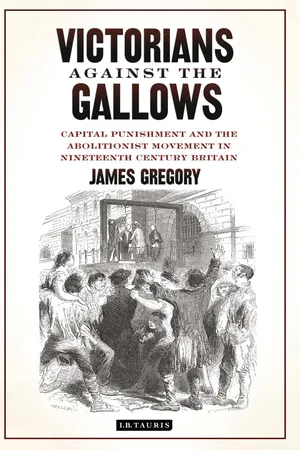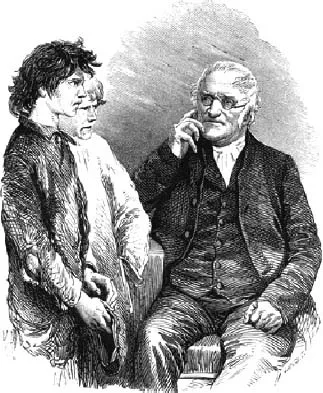![]()
1
THE RISE AND DECLINE OF THE MOVEMENT
The S.A.C.P.’s commitment to abolition of the gallows was unambiguously expressed in its name. Its early promoters denied having a duty to provide a substitute, but this became one of the concerns of abolitionist literature over the period, though it was never stated univocally what the substitute should be.1 Abolition was a clear and easily intelligible task. Such a focused aim makes it appear a classic Victorian ‘fad’ or ‘crotchet’, though abolition did not fall into the error of some single-issue campaigns promoted as ‘a universal panacea, ending a great number of the evils to which society had become subject’.2 This chapter outlines the precursors to the S.A.C.P., its basic chronology and political context. The abolitionist movement was opportunistic: sensitive to current affairs such as gallows scandals involving bungled executions or controversial sentences. Like any other pressure from without, its fortunes waxed and waned according to the national political scene and the competing interests of activists who might be distracted by many other philanthopric or political causes.
The S.A.C.P. was founded in April 1846 in that famous metropolitan centre for Protestant Evangelicalism, social reform and general philanthropy, Exeter Hall, a large building above whose Corinthian-columned entrance opening on to the Strand there appeared appropriately the Greek inscription to ‘loving brethren’.3 The meeting for its inauguration was trailed in advance by the metropolitan press.4
As an organized expression of opposition to penal practices, the S.A.C.P. was not a novel development, and what follows is a brief survey of the abolitionist societies active in the early nineteenth century. These small societies, supported by Quakers and Evangelicals, were frequently bankrupted when their limited budgets were exhausted in printing books and tracts to shape public opinion and influence parliament. One recent study of reform efforts in this period credits the ‘carefully controlled agitation’ of these societies in making criminal law reform ‘politically plausible’ and argues that ‘the Capital Punishment Society clearly was believed in its own time to have been speaking for a considerable portion of the population, and that is what established it as one of the shapers of public opinion.’5
Reform of the legal and penal systems obviously involved far more than the question of the death penalty throughout our period.6 The title of the first anti-capital punishment society in Britain, the Society for the Diffusion of Knowledge Respecting the Punishment of Death and the Improvement of Prison Discipline (hereafter, S.D.K.P.D.I.P.D.), conveys this wider penal interest. There was also a separate society for prison discipline, which attracted some of the core abolitionists, but which in general (until the later 1820s) avoided public connection with the capital punishment question.7
One important supporter of the S.D.K.P.D.I.P.D. was the legal author Basil Montagu, the illegitimate son of the fourth earl of Sandwich, a man of ‘fine, aristocratic features, a perfect address, totally devoid of the barrister’s impertinence and forwardness’.8 Through his pamphlets and what became a three-volume collection of authorities on capital punishment, Montagu became the most prominent publicist for the reform of the criminal code in this period.9 Other key figures included the Quakers Samuel Hoare, Frederick Smith of Croydon (a chemist-druggist and convert to Quakerism), William Forster, and Luke Howard (meteorologist and partner in a firm of chemists, which included the Quaker reformer William Allen, at Plough Court in Lombard Street), the radical and friend of Charles Lamb, George Dyer, and the radical publisher Richard Phillips.10 Quaker families associated with the society included the Frys, Buxtons, Gurneys and Fosters. The society’s supporters came also from the established church, with six clergymen on the London committee, including Samuel Wix, vicar of St Bartholomew the Less, Daniel Wilson (later Bishop of Calcutta) and the bibliophile and erstwhile republican Archdeacon Francis Wrangham.11 Anglican clergy were also represented on a Dublin committee.
The abolitionist society supported the parliamentary campaigners for criminal law reform such as the Whig politician and lawyer Sir Samuel Romilly and helped publicize parliamentary debates through their pamphlets.12 But the policy of diffusion of information was costly and bankrupted the society 1814–1815. In 1817 the society, following Romilly’s belief in prosecutor and juror reluctance to prosecute and convict, attempted to obtain ‘interesting cases’ of capital punishment from provincial supporters.13 These supporters were now encouraged, in a shift in the society’s tactics away from metropolitan domination and tight control of membership, to form provincial societies.14
The society’s financial straits reflects the relative significance of capital punishment as a concern for its chief supporters in the early-nineteenth century, the Society of Friends. Although the Quakers were to be associated by the Victorian press with efforts to eradicate the death penalty and although they were undeniably one of the most important components of the wider penal reform movement (in societies such as The Society for Investigating the Alarming Increase of Juvenile Delinquency in the Metropolis, co-founded by the Quaker Peter Bedford in 1815) their support for anti-slavery efforts dwarfed their activities against the gallows and the Bloody Code.15
A change in the society’s name in these years followed a dormant period brought about by financial weakness. The Society for the Diffusion of Information on the Subject of Capital Punishment (hereafter S.D.I.S.C.P.), established in 1820, saw its role as publishing metropolitan and provincial facts about capital punishment, promoting petitions to parliament and letters to MPs and peers, circulating pamphlets, and obtaining necessary funds.16 It lapsed after a few years, to be revived in 1829 without a title change, until reformation with a more militant title in 1846.
FIGURE 1. ‘Peter Bedford conversing with two Thieves’. Frontispiece from W. Tallack, Peter Bedford, the Spitalfields Philanthropist (London: S.W. Partridge, 1865). Courtesy of Society of Friends Library.
Although the archive for the earlier societies is almost limited to the tracts they produced, a report dated March 1845 includes a statement of the accounts, and a list of contributors for 1828–1845 lists some 130 named individuals and family members, with places of residence providing information on geographical concentrations of support. The list indicates the prominence of Quaker support and also reveals some Unitarian support.17 The Quaker journal The Friend reported the committee’s claim to have ‘established an extensive Correspondence’, in 1830.18 Support came predominantly from London, but Quaker subscribers came from other Quaker centres such as Hitchin in Hertfordshire, Sidcot in Somerset and Bristol.
Key abolitionists in this period included Peter Bedford, the retired manufacturing chemist John Thomas Barry who was a former partner of Allen’s in the business at Plough Court and Thomas B. Wrightson, a member of the London Peace Society whose pamphlet on capital punishment reached several editions, and who also continued to be involved with the movement after 1846.19 Barry’s figure ‘dressed in the friendliest of [F]riends’ costumes’ (he had become a Quaker early in life), became familiar gliding quietly through the corridors into the lobby of the House of Parliament.20 Tall and slim, ‘his head was remarkably well developed and fine in form, his nose long and aquiline and his features strongly expressive of the calm refined thoughtfulness of his mind,’ an obituarist wrote. His own strategy, since public feeling was fickle and would not support any long continued agitation, was to show by ‘persistent efforts the injustice, impolicy and inconsistency of the law in dealing with individual offenders’. By force of circumstances rather than argument, he hoped to convert the administrators of the law into allies or supporters.21 As one friend of the ‘untiring advocate’ privately wrote in 1843, Barry’s health was ‘much shattered by his great exertions’.22
Wrightson, whose brother William was MP for Northallerton, was mentioned as a Liberal candidate for Sheffield in 1837, when the support of local Quakers seems to have been canvassed on the basis of his devotion to criminal law reform – he was also a supporter of the ballot and disestablishment of the Church of England.23
It is interesting to see a number of female contributors to the society, particularly given the absence of named women involved in the S.A.C.P. The abolitionist society in 1831–1832 asserted the ‘inestimable value’ of the involvement of the ‘softer sex’, on the grounds that they felt ‘for the misery of the widows and orphans which the system creates’.24 Such women, mainly Quakers, gave some generous contributions. The average contribution was a few pounds as a one-off payment, which suggests involvement due to the visit of a member of the abolition society to a locality or town, possibly in connection with petitioning efforts for reprieve in a particular capital case. The largest sum donated was £300 anonymously via Barry. From 1830–1844 a total of £1,462 6s 4d was donated to the society, including sums from groups in Ireland. The larger sums tended to be tied to specific purposes.
Petitioning efforts for reform of the capital code were encouraged by S.D.I.S.C.P. advertisements in English, Scottish and Irish newspapers. The society had a committee in Dublin (entitled the Howard Society for Improvement of Prisons, and the Abolition of the Punishment of Death25) and in Edinburgh (founded in April 1830). These committees held public meetings in 1836 but the Edinburgh society was publicly rebuked for linking its efforts with the Scottish Prison Discipline Society.26 Stimulated by the S.D.I.S.C.P. or organized independently by religious denominations or communities, petitions were organized to further reform the law: thus the general Baptist churches at Leicester petitioned parliament to abolish capital punishment for all crimes except murder in 1838.27
Some insight on activities in the 1830s is derived from the letters published by the solicitor, William Sandford Phillips of Liverpool, who was also interested in reform of secondary punishments and the problem of juvenile delinquency (Barry cautioned him to avoid subjects that would confuse the goals of the Capital Punishment Society).28 His Considerations on the Increase and Progress of Crime allows us to trace some of the efforts of the ‘central society’ in London, and the Howard Society in Dublin, with letters between him and John McCay, an abolitionist who had been assistant secretary to the Bank of Ireland, the parliamentary abolitionist William Ewart (Liberal MP for Dumfries), and John Thomas Barry.29 An allusion to ‘Howard Trinity’ reports suggests co-ordinated activities by the London, Dublin and Edinburgh societies. The honorary secretary of the London society for eleven years, William B. Sarsfield Taylor, testified to the ‘untiring zeal, intelligence, and judicious perseverance, with which these societies carried on their movements, and co-operated in the most cordial manner to regenerate and purge ... the criminal code of Great Britain’.30 Phillips established a Liverpool branch of the ‘Capital Punishment Society’ in February 1833.31
Prince Augustus Frederick, Duke of Sussex, the Whiggish sixth son of George III, prized by Ewart for his ‘general consistency of principle – and his independence, as well as dignified station’ became the S.D.I.S.C.P.’s patron in 1832.32 This was the year of the Great Reform Act, and Ewart expressed his faith that the reformed parliament, representing the people, would pass ameliorating legislature as the people had ‘long since declared their hostility to laws at once sanguinary and inefficient’.33
Romilly’s parliamentary exertions from 1808 until his suicide in November 1818 had little immediate success. Though his efforts and those of the extra-parliamentary abolitionists had a role in the amelioration of the sanguinary code which had dealt so harshly with property crimes (including such petty pilferings as the theft of a shilling from a dwelling place or five shillings from a shop), the transformation that took place in the 1830s was the result of Sir Robert Peel’s consolidation of the criminal law, and the repeal of a large number of capital offences by Lord John Russell. By the accession of Queen Victoria capital punishment was limited only to treason, murder, rape, sodomy, and violent theft.34
Harriet Martineau’s History of the Thirty Years’ Peace commented on this capital law amelioration, that those who understood the subject had become advocates of total abolition, the facts and figures apparently leaving no doubt about the result of...

